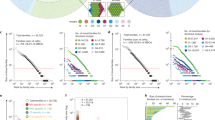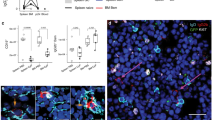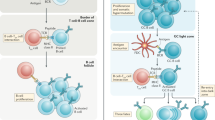Abstract
B-cell memory is provided by populations of quiescent memory B cells and long-lived plasma cells. Whereas it is clear that both of these cell populations arise from germinal centres, the signals and circumstances that trigger germinal-centre B cells to enter and then persist in memory compartments are poorly defined. Here, I propose that germinal centres produce memory B cells and plasma cells throughout the immune response and that memory B cells arise by the emigration of B cells that are chosen at random from the pool available in the germinal centre. The ability of such emigrants to survive as memory B cells depends on their germinal-centre 'history', with the persistence of high-affinity B-cell variants being favoured.
This is a preview of subscription content, access via your institution
Access options
Subscribe to this journal
Receive 12 print issues and online access
$209.00 per year
only $17.42 per issue
Buy this article
- Purchase on Springer Link
- Instant access to full article PDF
Prices may be subject to local taxes which are calculated during checkout


Similar content being viewed by others
References
Rajewsky, K. Clonal selection and learning in the antibody system. Nature 381, 751–758 (1996).
Zinkernagel, R. M. et al. . On immunological memory. Annu. Rev. Immunol. 14, 333–367 (1996).
Zinkernagel, R. M. What is missing in immunology to understand immunity? Nature Immunol. 1, 181–185 (2000).
Lanzavecchia, A. & Sallusto, F. Progressive differentiation and selection of the fittest in the immune response. Nature Rev. Immunol. 2, 982–987 (2002).
Manz, R. A. et al. . Maintenance of serum antibody levels. Annu. Rev. Immunol. 23, 367–386 (2005).
Alugupalli, K. R. et al. . B1b lymphocytes confer T cell-independent long-lasting immunity. Immunity 21, 379–390 (2004).
Klein, U. et al. . Human immunoglobulin (Ig)M+IgD+ peripheral blood B cells expressing the CD27 cell surface antigen carry somatically mutated variable region genes: CD27 as a general marker for somatically mutated (memory) B cells. J. Exp. Med. 188, 1679–1689 (1998).
Tangye, S. G. et al. . Identification of functional human splenic memory B cells by expression of CD148 and CD27. J. Exp. Med. 188, 1691–1703 (1998).
Ehrhardt, G. R. et al. . Expression of the immunoregulatory molecule FcRH4 defines a distinctive tissue-based population of memory B cells. J. Exp. Med. 202, 783–791 (2005).
MacLennan, I. C. Germinal centers. Annu. Rev. Immunol. 12, 117–139 (1994).
Dal Porto, J. M. et al. . Very low affinity B cells form germinal centers, become memory B cells, and participate in secondary immune responses when higher affinity competition is reduced. J. Exp. Med. 195, 1215–1221 (2002).
Shih, T. A. et al. . Role of BCR affinity in T cell dependent antibody responses in vivo . Nature Immunol. 3, 570–575 (2002).
Cyster, J. G. Chemokines, sphingosine-1-phosphate, and cell migration in secondary lymphoid organs. Annu. Rev. Immunol. 23, 127–159 (2005).
MacLennan, I. C. et al. . Extrafollicular antibody responses. Immunol. Rev. 194, 8–18 (2003).
Smith, K. G. et al. . The phenotype and fate of the antibody-forming cells of the splenic foci. Eur. J. Immunol. 26, 444–448 (1996).
Haberman, A. M. & Shlomchik, M. J. Reassessing the function of immune-complex retention by follicular dendritic cells. Nature Rev. Immunol. 3, 757–764 (2003).
Zhang, J. et al. . B cell memory to thymus-independent antigens type 1 and type 2: the role of lipopolysaccharide in B memory induction. Eur. J. Immunol. 18, 1417–1424 (1988).
Obukhanych, T. V. & Nussenzweig, M. C. T-independent type II immune responses generate memory B cells. J. Exp. Med. 203, 305–310 (2006).
Herzenberg, L. A. B-1 cells: the lineage question revisited. Immunol. Rev. 175, 9–22 (2000).
Toyama, H. et al. . Memory B cells without somatic hypermutation are generated from Bcl6-deficient B cells. Immunity 17, 329–339 (2002).
McHeyzer-Williams, L. J. et al. . Antigen-specific B cell memory: expression and replenishment of a novel B220− memory B cell compartment. J. Exp. Med. 191, 1149–1166 (2000).
Manz, R. A. et al. . Survival of long-lived plasma cells is independent of antigen. Int. Immunol. 10, 1703–1711 (1998).
Shapiro-Shelef, M. et al. . Blimp-1 is required for the formation of immunoglobulin secreting plasma cells and pre-plasma memory B cells. Immunity 19, 607–620 (2003).
Mack, M. et al. . Identification of antigen-capturing cells as basophils. J. Immunol. 174, 735–741 (2005).
Bell, J. & Gray, D. Antigen-capturing cells can masquerade as memory B cells. J. Exp. Med. 197, 1233–1244 (2003).
Kallies, A. et al. . Plasma cell ontogeny defined by quantitative changes in Blimp-1 expression. J. Exp. Med. 200, 967–977 (2004).
Blink, E. J. et al. . Early appearance of germinal center-derived memory B cells and plasma cells in blood after primary immunization. J. Exp. Med. 201, 545–554 (2005).
O'Connor, B. P. et al. . Short-lived and long-lived bone marrow plasma cells are derived from a novel precursor population. J. Exp. Med. 195, 737–745 (2002).
Tew, J. G. et al. . A subpopulation of germinal center B cells differentiate directly into antibody forming cells upon secondary immunization. Adv. Exp. Med. Biol. 237, 215–220 (1988).
Angelin-Duclos, C. et al. . Commitment of B lymphocytes to a plasma cell fate is associated with Blimp-1 expression in vivo . J. Immunol. 165, 5462–5471 (2000).
Kawabe, T. et al. . The immune responses in CD40-deficient mice: impaired immunoglobulin class switching and germinal center formation. Immunity 1, 167–178 (1994).
Han, S. et al. . Cellular interaction in germinal centers. Roles of CD40 ligand and B7-2 in established germinal centers. J. Immunol. 155, 556–567 (1995).
Tangye, S. G. et al. . Intrinsic differences in the proliferation of naive and memory human B cells as a mechanism for enhanced secondary immune responses. J. Immunol. 170, 686–694 (2003).
Hasbold, J. et al. . Evidence from the generation of immunoglobulin G-secreting cells that stochastic mechanisms regulate lymphocyte differentiation. Nature Immunol. 5, 55–63 (2004).
Arpin, C. et al. . Generation of memory B cells and plasma cells in vitro . Science 268, 720–722 (1995).
Randall, T. D. et al. . Arrest of B lymphocyte terminal differentiation by CD40 signaling: mechanism for lack of antibody-secreting cells in germinal centers. Immunity 8, 733–742 (1998).
Muramatsu, M. et al. . Class switch recombination and hypermutation require activation-induced cytidine deaminase (AID), a potential RNA editing enzyme. Cell 102, 553–563 (2000).
Dedeoglu, F. et al. . Induction of activation-induced cytidine deaminase gene expression by IL-4 and CD40 ligation is dependent on STAT6 and NFκB. Int. Immunol. 16, 395–404 (2004).
Kehry, M. R. CD40-mediated signaling in B cells. Balancing cell survival, growth, and death. J. Immunol. 156, 2345–2348 (1996).
Tuscano, J. M. et al. . Bcl-x rather than Bcl-2 mediates CD40-dependent centrocyte survival in the germinal center. Blood 88, 1359–1364 (1996).
Huntington, N. D. et al. . CD45 links the B cell receptor with cell survival and is required for the persistence of germinal centers. Nature Immunol. 7, 190–198 (2006).
Liu, Y. J. et al. . Mechanism of antigen-driven selection in germinal centres. Nature 342, 929–931 (1989).
Liu, Y. J. et al. . Germinal center cells express bcl-2 protein after activation by signals which prevent their entry into apoptosis. Eur. J. Immunol. 21, 1905–1910 (1991).
Lanzavecchia, A. Antigen-specific interaction between T and B cells. Nature 314, 537–539 (1985).
Batista, F. D. & Neuberger, M. S. Affinity dependence of the B cell response to antigen: a threshold, a ceiling, and the importance of off-rate. Immunity 8, 751–759 (1998).
Cortes, M. & Georgopoulos, K. Aiolos is required for the generation of high affinity bone marrow plasma cells responsible for long-term immunity. J. Exp. Med. 199, 209–219 (2004).
Takahashi, Y. et al. . In situ studies of the primary immune response to (4-hydroxy-3-nitrophenyl)acetyl. V. Affinity maturation develops in two stages of clonal selection. J. Exp. Med. 187, 885–895 (1998).
Smith, K. G. et al. . The extent of affinity maturation differs between the memory and antibody-forming cell compartments in the primary immune response. EMBO J. 16, 2996–3006 (1997).
Paus, D. et al. . Antigen recognition strength regulates the choice between extrafollicular plasma cell and germinal center B cell differentiation. J. Exp. Med. 203, 1081–1091 (2006).
Su, G. H. et al. . Defective B cell receptor-mediated responses in mice lacking the Ets protein, Spi-B. EMBO J. 16, 7118–7129 (1997).
Gray, D. A role for antigen in the maintenance of immunological memory. Nature Rev. Immunol. 2, 60–65 (2002).
Baine, Y. & Thorbecke, G. J. Induction and persistence of local B cell memory in mice. J. Immunol. 128, 639–643 (1982).
Bachmann, M. F. et al. . Induction of long-lived germinal centers associated with persisting antigen after viral infection. J. Exp. Med. 183, 2259–2269 (1996).
Takahashi, Y. et al. . Fas is required for clonal selection in germinal centers and the subsequent establishment of the memory B cell repertoire. Immunity 14, 181–192 (2001).
Smith, K. G. et al. . bcl-2 transgene expression inhibits apoptosis in the germinal center and reveals differences in the selection of memory B cells and bone marrow antibody-forming cells. J. Exp. Med. 191, 475–484 (2000).
Maruyama, M. et al. . Memory B-cell persistence is independent of persisting immunizing antigen. Nature 407, 636–642 (2000).
Schluns, K. S. & Lefrancois, L. Cytokine control of memory T-cell development and survival. Nature Rev. Immunol. 3, 269–279 (2003).
Shapiro-Shelef, M. & Calame, K. Regulation of plasma-cell development. Nature Rev. Immunol. 5, 230–242 (2005).
Shaffer, A. L. et al. Blimp-1 orchestrates plasma cell differentiation by extinguishing the mature B cell gene expression program. Immunity 17, 51–62 (2002).
Ozaki, K. et al. . Regulation of B cell differentiation and plasma cell generation by IL-21, a novel inducer of Blimp-1 and Bcl-6. J. Immunol. 173, 5361–5371 (2004).
Vinuesa, C. G. et al. . Follicular B helper T cells in antibody responses and autoimmunity. Nature Rev. Immunol. 5, 853–865 (2005).
Bernasconi, N. L. et al. . Maintenance of serological memory by polyclonal activation of human memory B cells. Science 298, 2199–2202 (2002).
Acknowledgements
I thank current and previous members of my laboratory who have worked on this problem. I am also grateful to the other members of the B-cell Program for fruitful and stimulating discussions. D.T. is supported by grants from the National Health and Medical Research Council (Australia).
Author information
Authors and Affiliations
Ethics declarations
Competing interests
The author declares no competing financial interests.
Supplementary information
Rights and permissions
About this article
Cite this article
Tarlinton, D. B-cell memory: are subsets necessary?. Nat Rev Immunol 6, 785–790 (2006). https://doi.org/10.1038/nri1938
Issue Date:
DOI: https://doi.org/10.1038/nri1938
This article is cited by
-
High-affinity IgM+ memory B cells are defective in differentiation into IgM antibody-secreting cells by re-stimulation with a T cell-dependent antigen
Scientific Reports (2018)
-
Autonomous membrane IgE signaling prevents IgE-memory formation
Nature Immunology (2016)
-
Mcl-1 is essential for the survival of plasma cells
Nature Immunology (2013)
-
Functionally Distinct Subpopulations of CpG-Activated Memory B Cells
Scientific Reports (2012)
-
In-vitro derived germinal centre B cells differentially generate memory B or plasma cells in vivo
Nature Communications (2011)



